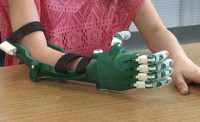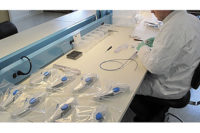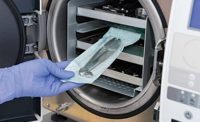Designing a new medical device is a bit more complicated than designing a toaster or an automotive cooling system. Besides the issues common to any product—feasibility, usability, and design for manufacture and assembly—there are also issues of biocompatibility, sterilization and FDA regulations to deal with.
It’s enough to overwhelm even experienced engineers. That’s why some manufacturers turn to third-party medical device design firms.
With growing product complexity, new types of materials, shorter time to market, increased regulatory oversight and rising stakes for product failures, it’s more important than ever to consider this option. In fact, several recent trends have put product design in the spotlight.
“Medical devices are now widely connected and serving different constituents, such as physicians, caregivers and patients,” says Stuart Karten, principal of Karten Design, a company that has developed many types of products, including defibrillators, dental tools, hearing aids and heart monitors. “A deep understanding of the technical and human factors related to connectivity play a critical role.”
According to Karten, device and app engagement has “become a driving factor for FDA approval because physicians, hospitals and patients are demanding it. And, the Affordable Care Act mandates penalties for readmission, so products must be easily understood and provide the right outcomes.”
“Creating a novel medical device is really a process that requires a multidisciplinary team,” adds Tiffany Wilson, CEO of the Global Center for Medical Innovation and T3 Labs. “Many innovators and startup firms don’t realize that the developmental pathway they are entering into is highly regulated and ever-changing.
“Now, more than ever, because of the Affordable Care Act and ongoing shifts in healthcare regulation, it is important to engage a firm that can help you design your device with manufacturing requirements in mind from the start,” claims Wilson. “Medical device firms should also possess the knowledge and resources that maximize the potential for FDA clearance, and understand what type of data payers will be looking for.”
Wilson says it’s still possible for a small startup company to do all that on its own. However, it’s likely to burn through valuable time, make mistakes and spend more capital to complete the concept-to-commercialization process.
User-centric design, human factors and usability engineering are playing an increasingly important role in the medical device industry. As outlined in a final guidance document issued by the FDA last year (Applying Human Factors and Usability Engineering to Medical Devices), design for human factors is central to increasing patient and user safety, and to minimizing the risks of potential misuse.
“These factors often conspire to motivate device manufacturers to seek out specific expertise for new product development,” says John Cogger, president of Innova Engineering Inc., an engineering services firm that has worked with numerous companies. “External design firms can bring expertise amassed through a history of working on a wide variety of products.
“Device manufacturers that may infrequently develop new products often have staff that are focused primarily on sustaining engineering of existing products; developing new and innovative products requires different skill sets,” warns Cogger. “It is often more efficient to acquire these skills by developing a relationship with competent third-party design firms.”
Third-Party Benefits
According to Dan Stipe, senior director of industrial design at Forma Medical Device Design, there are three main reasons to consider an external design firm:
- They provide an unbiased perspective.
- They provide expertise in various technical areas that some medical device manufacturers may lack internally.
- They provide an ability to employ efficient development practices gained through experience working on a range of different medical products. Knowing what works and what doesn’t is in their DNA.
“Independent design firms also bring expertise in aesthetics, ergonomics and user interface needs,” adds Stipe, who has worked with leading medical device manufacturers such as Becton, Dickinson and Johnson & Johnson. “Most companies focused solely on engineering lack that on their internal teams. In particular, industrial design firms usually have research capabilities.
“They can obtain critical insight into user needs that form the foundation of the product,” explains Stipe. “Internal teams that have worked on the same types of products for a long time tend to get stuck in a rut. An independent firm can bring new approaches.”
“A third-party design firm can offer a wealth of experience, both from within the medical product sector and from the world of consumer and industrial products,” adds David Schiff, director of research and development at the Bresslergroup, which has been designing medical devices since 1970. “The result can be access to relevant ideas and inventions often beyond the exposure of the typical medical device manufacturer.
“The medical design community’s relatively recent focus on human factors is not new to industrial design and engineering firms,” adds Schiff. “They have focused on this aspect of design for years while developing both medical and consumer products.
“As surgeons, nurses, patients, and other users of medical products become more sophisticated through exposure to advanced products in the consumer electronics sphere, there is an expectation that all products possess a similar level of design consideration.”
“The design or product development firm usually has the ability to be nimbler and to change direction more quickly, due to fewer layers of management compared to the typical manufacturing firm,” Schiff points out. “The result can often be reduced time to market.
“An effective outside design firm provides the opportunity and expertise to enable the consideration and incubation of creative solutions that may not be given a chance to gestate within the corporate environment,” claims Schiff.
Outsourcing design is often a good option for new product development, because outside talents can benefit the project.
“Product design firms typically have a good handle on what consumers want and need,” says Len Czuba, president of Czuba Enterprises Inc., an independent design firm that specializes in plastic medical devices. “They also have experience using new materials, new plastic molding processes and new joining techniques. That kind of expertise and exposure to creating items such as appliances, electronics and toys is invaluable.
“Most medical device companies don’t have that kind of breathe of experience,” Czuba points out. “They tend to be quite parochial and cloistered.”
Design in Action
A third-party design firm can help establish a user-centric product development process, which is becoming increasingly important today.
Medical devices have become more complex, because there are multiple end users, such as patients, physicians, nurses and caregivers.
“A physician might want data from a device, but a patient wants something that’s actionable,” says Eric Olson, director of design at Karten Design. “Understanding these issues has become very important. We are no longer in the era of standalone devices, because the world has changed.
“We live in an interconnected, mobile world in which people receive as much care in their homes as they do in a hospital,” notes Olson. “People expect their devices to be well-designed, intelligently connected and create good outcomes. It’s an exciting time in medical device design.
“Medical devices must be practical and work efficiently, but they must also connect on an emotional level,” claims Olson. “[Companies] experienced in device design will have a rich set of skills that can bring a multidisciplinary approach to a project.”
Olson says a good example is Axonics Modulation Technologies Inc., a company that Karten recently worked with. The startup firm was founded four years ago to develop next-generation technology to address issues of overactive bladder, which is the most common form of urinary dysfunction.
“These conditions impose significant quality of life and financial burdens on individuals, their families and healthcare organizations,” says Olson.
To treat the condition, Axonics developed a miniaturized implanted neuromodulation device that sends mild electrical pulses to stimulate the sacral nerves located in the pelvis. Sacral neuromodulation is the only FDA-approved therapy to treat both urinary and fecal symptoms with a single device.
“As Axonics began to develop its core technology, it understood that enlightened design would add real value,” notes Olson. “Ray Cohen, the company’s CEO, insisted that the product be designed for patients. He purposefully kept Axonics engineers away from making decisions that would affect patient-facing and physician-facing product design.”
“Engineers typically approach a product from a technology standpoint, leaving design until the end,” says Cohen, who asked Karten Design to study urinary dysfunction and what it’s like for a person to live and interact with an implantable device from the patient’s point of view. “I wanted to do things differently—to have the design influence every part of the product and the user experience.”
“Medical product design is transforming, because of technologic and societal changes that elevate the patient’s role in medical outcomes,” explains Olson. “To engage patients in necessary behavior change, design must now address the unique needs of patients.
“In 2013, we started studying the behaviors and needs of patients with implantable neurostimulators,” says Olson. “Our work helped Axonics [generate] more than $32 million in Series A financing in early 2014.”
To not bias any outcomes, Axonics allowed Karten Design to approach the issue organically. They studied existing and analogous therapies, competitive products, and interviewed dozens of patients.
“It became crystal clear that we could seriously improve the patient experience,” recalls Cohen. “It’s no longer good enough in med-tech to come up with a technology that’s faster and better. It must be cost-effective, address clinician needs and delight patients.”
“Along with addressing the technical needs, we understood that we had to take patient embarrassment out of the equation by creating a minimalistic [device] that was less disruptive to patients’ lives,” adds Olson. “In doing so, we designed the Axonics SNM System, which is a rechargeable implantable neuromodulation system.”
Among other innovations, it includes a miniaturized implantable pulse generator that is 60 percent smaller and is qualified to last at least 15 years in the body. That’s more than three times longer than currently marketed nonrechargeable sacral neuromodulation technology.









